Category:
General musings
Memorial Day 2007
Notice: Use of undefined constant the_post_thumbnail - assumed 'the_post_thumbnail' in /home/netscrib/public_html/civilwarcavalry/wp-content/themes/wittenberg/archive.php on line 65

Old men forget: yet all shall be forgot,
But he’ll remember with advantages
What feats he did that day: then shall our names.
Familiar in his mouth as household words
Harry the king, Bedford and Exeter,
Warwick and Talbot, Salisbury and Gloucester,
Be in their flowing cups freshly remember’d.
This story shall the good man teach his son;
And Crispin Crispian shall ne’er go by,
From this day to the ending of the world,
But we in it shall be remember’d;
We few, we happy few, we band of brothers;
For he to-day that sheds his blood with me
Shall be my brother; be he ne’er so vile,
This day shall gentle his condition:
And gentlemen in England now a-bed
Shall think themselves accursed they were not here,
And hold their manhoods cheap whiles any speaks
That fought with us upon Saint Crispin’s day.
–William Shakespeare
Henry V, Act 4, Scene III
I’ve been watching Band of Brothers on The History Channel for much of the day. This magnificent miniseries never ceases to move me immensely. These men were truly the Greatest Generation.
Thank you to all American veterans of all branches of services, past, present, and future. Thank you for everything you have done to ensure that we Americans continue to enjoy liberties that we probably never fully appreciate. Thank you for your sacrifices on our behalf, for leaving your families to serve and protect us. And to those who have made the ultimate sacrifice, we owe you the greatest debt of gratitude of all.
Today is also Susan’s birthday. Happy birthday to my best friend, companion, and favorite battlefield stomping buddy.
Scridb filterPassages
Notice: Use of undefined constant the_post_thumbnail - assumed 'the_post_thumbnail' in /home/netscrib/public_html/civilwarcavalry/wp-content/themes/wittenberg/archive.php on line 65

Susan and I went to Pittsburgh for the day yesterday to attend the wedding of some close friends. There was something extremely appropriate about my being in the Steel City yesterday. Yesterday was the 20th anniversary of my graduation from the University of Pittsburgh School of Law. I moved to Columbus on June 1, 1987, and I’ve been here ever since.
It hardly seems possible that twenty years have passed since that roasting hot, humid day, but they clearly have. If you had asked me then whether I’d still be here in Columbus twenty years later, I would have told you that you were out of your mind, but it’s true. And so it goes…..
Scridb filterPhotos from the Trip
Notice: Use of undefined constant the_post_thumbnail - assumed 'the_post_thumbnail' in /home/netscrib/public_html/civilwarcavalry/wp-content/themes/wittenberg/archive.php on line 65

Below are photos from the recent trip to North Carolina. The first photograph is of a Confederate light saber recovered from the Monroe’s Crossroads battlefield that is owned by a fellow named Al Potts. The wrist guard is bent, but Mr. Potts does not know whether it is battle damage. The blade is pretty chewed up, but I couldn’t tell if it was from battle or from being exposed to the elements. The next batch of photos are from the Guilford Court House National Military Park. There are 32 monuments on the Guilford Court House battlefield and we photographed most of them. The last batch of pictures are from the Jeb Stuart birthplace.
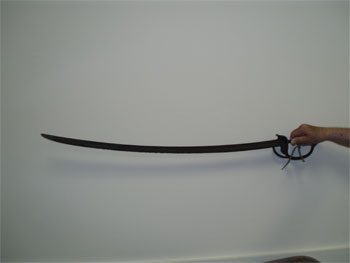
This is Al Pott’s Ames Confederate saber, found on the Monroe’s Crossroads battlefield before it was part of Fort Bragg. It’s oxidized black. The blade, as you can see, is in rough shape. The wrist guard is damaged.
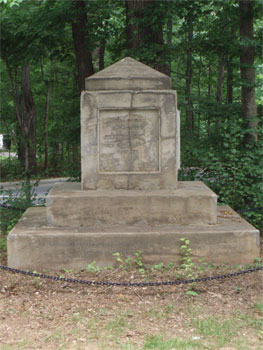
This is the grave of Brig. Gen. Jethro Sumner, who commanded the 3rd North Carolina Infantry from 1776-1780. At the time of the Battle of Guilford Court House, he was a colonel. His unit did not fight in the battle. It was on detached duty in Hillsborough. However, Sumner was buried on the battlefield in 1891.
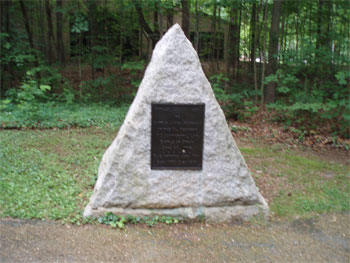
This is a monument to Capt. James Morehead. His descendant was one of the founders of the company that erected these monuments before the National Park Service acquired the land that makes up the park. The monument is shaped like a pup tent in honor of Morehead’s military service.
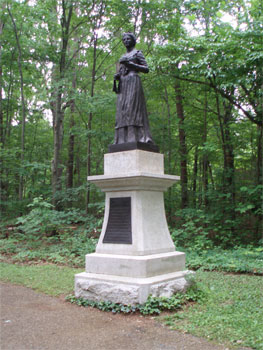
There are two monuments to women on the battlefield. Karrenhappuch Norman Turner was an ancestor of the Morehead family. According to family legend, she supposedly rode from Maryland to tend a seriously wounded son after the battle. The cup and towel in the statue’s hands were the simple tools of her care.
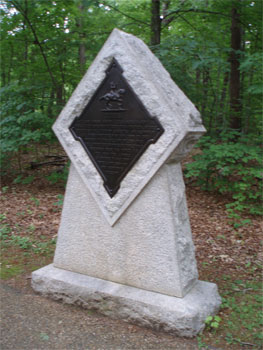
This is the Bugler Gillies Monument. James Gillies was a young bugler in “Lighthorse Harry” Lee’s Legion, killed by Tarleton’s British cavalry in February 1781 near present-day Oak Ridge.
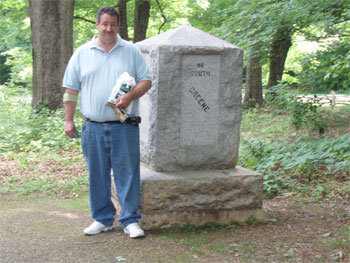
Me standing by the “No North, No South” monument, which was dedicated in 1903. It has Nathanael Greene’s name on one side with the word “South” and George Washington’s name on the other with the word “north”. The people who saw the split of the nation due to the Civil War in 1861 erected this monument to renewed nationalism. Greene, a New Englander, led southern troops while Washington, a southerner, led northern troops.
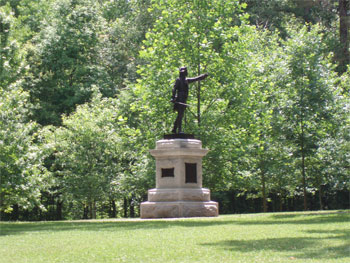
This is the Joseph Winston monument. It’s located on the end of the second American battle line. Major Joseph Winston commanded the Surry County, North Carolina militia in the battle.
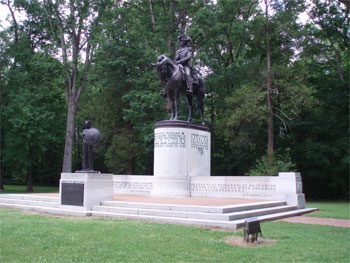
This handsome equestrian monument was dedicated in 1915. It depicts the American commander, Maj. Gen. Nathanael Greene. Greene was perhaps the finest of all of George Washington’s subordinates. The battle plan–a defense in depth–was designed by Greene, who earned the respect of his British counterpart, Charles Cornwallis.
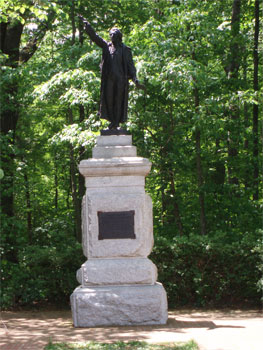
This monument commemorates the three Tarheels who signed the Declaration of Independence and marks the graves of two of them. William Hooper, Joseph Hewes, and John Penn all signed the Declaration of Independence in 1776. Hooper’s and Penn’s remains were re-bruied in the park in 1897, while Hewes’ remains lie in Christ Churchyard in Philadelphia. The monument and remains were moved to the present location in 1976. The bronze statue is of Hooper, the “Orator of the Congress”.
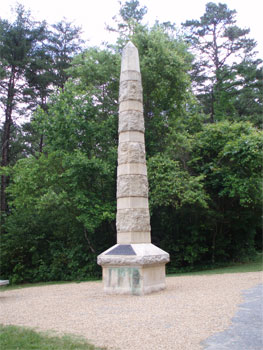
The American cavalry was honored by this monument. Two bronze tablets honor the “Virginia Giant” Peter Francisco, who killed eleven men with his broadsword during the Battle of Guilford Court House, Lt. Col. William Washington (cousin of George Washington, and commander of the American cavalry), and the Marquis de Britigny, a French volunteer.
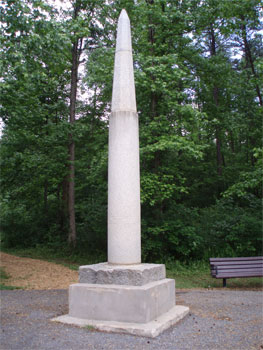
This is a monument to the Continental Regulars of Greene’s army. It was also supposed to mark the third American line of battle, but subsequent research has shown that it is misplaced by about a quarter of a mile. The real third line position was at the original county court house site, which sat atop a prominent ridge. Greene chose this position wisely, and it was stoutly defended by his Continentals.
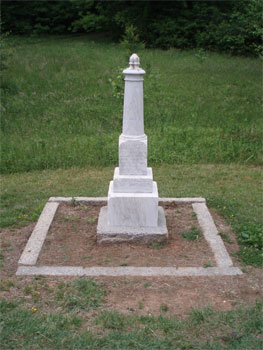
This is the James Stuart monument, which is the only monument on the battlefield to a British soldier. Lt. Colonel James Stewart (as spelled on British military documents) of the Brigade of Guards was killed in the fighting on the third line. The monument marks the spot where a sword was found in 1866. The sword was engraved with the coat of arms of the Bllantyre family, connecting it to Stewart.
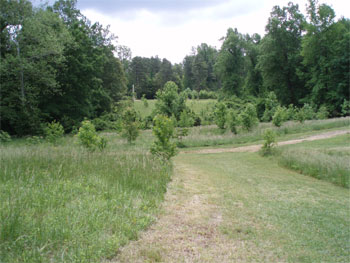
I took this beautiful panoramic view standing at the monument to the Continentals. The Stuart monument is partway down the ridge. You can see the Cavalry Monument in the distance on the other side of the valley. As stated above, the men who marked the field originally believed that this was the position of the American third line, but it wasn’t. I include this photo for a couple of reasons. First, you can see how beautiful this park is. Second, you can get a sense of the rolling terrain and very dense woods that played a major role in the development of this battle.
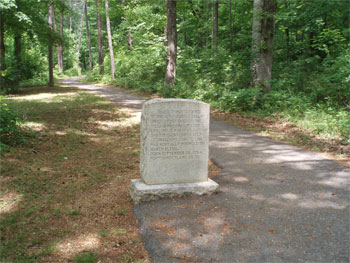
This was the last monument placed on the Guilford Court House battlefield in 1932. Capt. Griffin Murdock Fauntleroy of Northumberland County, Virginia was one of the most experienced soldiers in Nathanael Greene’s army. After serving in the 7th Virginia Infantry, he resigned his commission and instead accepted one as a captain in the First Continental Light Dragoons. He was mortally wounded and left on the battlefield at Guilford Court House.
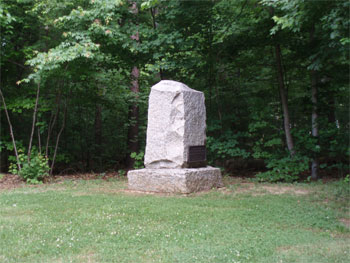
This is a monument to Nathaniel Macon, an officer in Greene’s army who left just before the battle to fill an elected seat in the North Carolina Assembly. He eventually became the Speaker of the United States House of Representatives.
That’s it for the Guilford Court House photos. The next batch come from the Jeb Stuart birthplace.
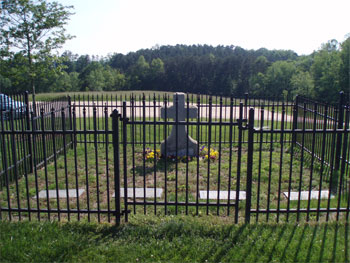
This fence and the cross are the original site of the graves of Jeb Stuart’s parents. The bodies were later disinterred and moved. However, they were an important part of the family farm, and their location remains marked by these cenotaphs today.
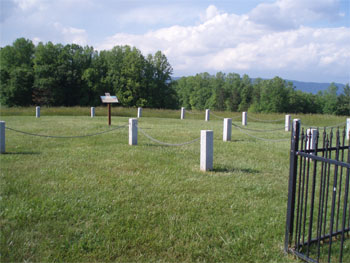
The family home burned in the 1840’s. Archaeologists have located the foundation. The granite markers show the perimeter of the house. Jeb Stuart was born in the house.
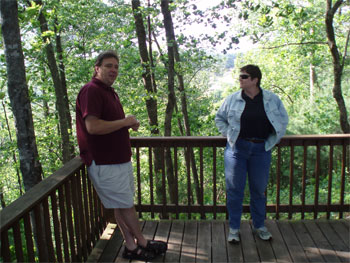
The Jeb Stuart Birthplace sits on a high ridge, overlooking the mighty Ararat River and the 1500 acres owned by Archibald Stuart. Jeb Stuart’s maternal great-grandfather, William Letcher, was a patriot. British Tories killed him during the Revolutionary War, and he was buried in the valley overlooking the mighty Ararat. It’s in the valley below. With Susan in this photo is Thomas D. Perry, whose efforts are responsible for saving and preserving the Jeb Stuart Birthplace.
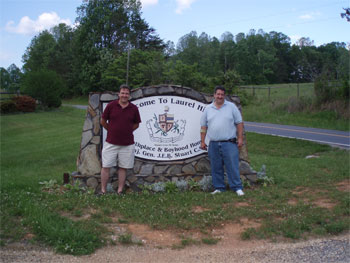
Tom and me by the big sign that marks the entry to the Birthplace property.
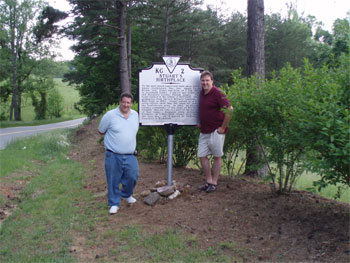
Tom and me by the Virginia state historical marker just outside the Birthplace property. Tom says that the prior version of this sign is what got him interested in Jeb Stuart and in the Civil War.
That’s it for the photos from this trip. I hope you’ve enjoyed them.
Scridb filterThe Horror
Notice: Use of undefined constant the_post_thumbnail - assumed 'the_post_thumbnail' in /home/netscrib/public_html/civilwarcavalry/wp-content/themes/wittenberg/archive.php on line 65

A week ago today, I had a horrifying realization, one I’ve been dreading for a LONG time.
We had dinner with another couple and then went to see Spiderman III. When we got to their house, I grabbed the newspaper to make sure of the times when the movie was playing, and realized that….I couldn’t read the fine print with the movie times!!! Rather suddenly, my arms had grown too short.
I had to borrow my friend Mark’s reading glasses in order to read the movie times. I’m 46, and I knew this day was coming, sooner than later. The next day, last Sunday, we went to Costco and I bought three pairs of +1.25 reading glasses for $18. That way, I have one pair for upstairs, one for downstairs, and one for the office.
The other night, after my talk in Pinehurst, a fellow brought up a photocopy of some information he thought I might be interested in, but the print was too small, and I didn’t have my reading glasses with me. I had to do the old hold the page as far away as I could so I could read it bit, and I suddenly felt VERY old. 🙁
There are some very effective bifocal contact lenses out there now. I’m hoping I might be eligible for them…..
Scridb filterThis Would Be Hilarious If It Wasn’t So Pathetic….
Notice: Use of undefined constant the_post_thumbnail - assumed 'the_post_thumbnail' in /home/netscrib/public_html/civilwarcavalry/wp-content/themes/wittenberg/archive.php on line 65

Brian Dirck has a post on his blog today that includes some of the more brilliant responses received from his students during the recent final exam period:
Among my more creative exam answers: manifest destiny” was, according to one student, “Beyonce gone wild.” Abraham Lincoln had a “leery” relationship with slavery. Lee was a Union hero, Grant was a Confederate, and Sherman trashed Ohio during his march to the sea (or perhaps that was the Great Lakes?). The Confederacy “succeeded” rather than “seceded,” and antebellum America had a “sexual crisis” of epic proportions.
This would be hilarious if it wasn’t so pathetic. How is it that history has gotten such short shrift in high school curricula that someone would actually equate Beyonce with the doctrine of manifest destiny? I’ll tell you. It’s that ridiculous No Child Left Behind nonsense instituted by the moron in the White House that emphasizes test scores over actual teaching. And that, my friends, is the most pathetic thing of all.
All I can think about when I consider this is the bumper sticker I saw last week: Somewhere in Texas, a village is missing its idiot. ‘Nuff said.
Scridb filterThis Stuff Amazes Me
Notice: Use of undefined constant the_post_thumbnail - assumed 'the_post_thumbnail' in /home/netscrib/public_html/civilwarcavalry/wp-content/themes/wittenberg/archive.php on line 65

Family legends are amazing things. Stories get passed down through families generation after generation, and they become the gospel truth whether they have any basis in fact or not. Some of them are really amazing. Based on these family legends, people persuade themselves that they’re related to famous people when there simply is no evidence that such is true.
Today, I got an e-mail from an acquaintance in Australia who passed along an e-mail from an individual, wanting to know whether I could help answering the question. Here’s the gist of it:
My husband is a descendent of Philip Henry Sheridan by Mary Jane (some say Mary Ann) Hankins of Ohio–his wife during the Civil War. Their son Will, who took his step-father’s Johnson name, and daughter Emma, were born during the war.
Mary Jane met the train every day for quite awhile after the war, but Sheridan had other plans, and, later, anothr family.
A few years ago, someone read an account of Sheridan’s wife and infant visiting his camp in Tennessee, but couldn’t remember any further info. Neither have I been able to locate any records. (Tried to check Ohio online.) Can you help?
This is particularly interesting, because Sheridan only ever married once, at 45 years of age in 1875. In short, he never had a wife during the Civil War. Now, I suppose it’s possible that he could have had illegitimate children, but there is absolutely no record to suggest that he was married during the war, and there is likewise nothing I’ve ever seen to suggest that he had any children other than his son Philip, Jr., who was born in 1880 and only lived to the age of 37. I had to tell my friend from Australia the truth, which is that there’s no way that this family legend could be true.
Where people get this stuff is really a mystery to me, and how they’ve managed to convince themselves that family legend is true is even more remarkable. I wish I knew where it comes from, but it frustrates me to no end. I hate to burst people’s bubbles, but the truth is much more important to me than coddling someone’s illusions of familial grandeur.
Scridb filterChancellorsville, Part Three
Notice: Use of undefined constant the_post_thumbnail - assumed 'the_post_thumbnail' in /home/netscrib/public_html/civilwarcavalry/wp-content/themes/wittenberg/archive.php on line 65

Tonight, in the final installment of this series, I will address the many connections between Chancellorsville and Gettysburg. I’ve long believed that nobody can ever truly understand Gettysburg without having a good understanding of Chancellorsville. The two are inexorably linked.
First, and foremost, Hooker had two full infantry corps that really didn’t even fire a shot in anger at Chancellorsville. Maj. Gen. John F. Reynolds’ I Corps was one of them. Reynolds was very aggressive, and it had to have driven him crazy to be held out of a large fight. Is it any wonder, therefore, that Reynolds pitched in so eagerly at Gettysburg on July 1? His aggressiveness cost him his life that morning, but not before validating John Buford’s decision to stand and fight at Gettysburg.
George Meade’s V Corps also didn’t do much fighting at Chancellorsville after the first day. Hooker held a council of war and didn’t listen to his corps commanders, who encouraged him to hold the good high ground the army occupied on May 1. Hooker withdrew and his army got clobbered. Again, is it any wonder that George Meade was so determined to hold the good high ground at Gettysburg?
Dan Sickles and III Corps were ordered to give up high ground and got clobbered by Confederate artillery when the Southern gunners took up the position Sickles had abandoned. As a result, Sickles was determined not to give up high ground where Confederate artillery could then be employed to hammer his men. Consequently, Sickles disobeyed orders and moved his entire corps forward to high ground along the Emmitsburg Road that he liked better, creating a salient that caused the sacrifice of his corps. The die for Sickles’ move forward at Gettysburg was cast at Chancellorsville.
Hooker sent his entire Cavalry Corps, save for one brigade, off on an extended raid behind enemy lines, thereby leaving his army blind and without any sort of an effective screen. That, in turn, meant that the Eleventh Corps flank was uncovered and in the air, setting it up to take the brunt of Jackson’s flank attack. Although Meade did a better job of using his cavalry at Gettysburg, there were similar problems, particularly when Pleasonton sent Buford’s two brigades to Maryland to guard wagon trains and left Sickles’ flank in the air
O. O. Howard’s performance at Chancellorsvile was atrocious. He ignored reports of a large enemy force operating on his flank and did nothing to prepare his men for an onslaught. Consequently, the XI Corps was overwhelmed and driven from the field. It never had a chance. The same thing happened at Gettysburg. Howard sent the XI Corps out onto flat ground on a plain below high ground held by Confederate artillery with no support and its flank in the air, and a savage enemy flank attack crashed into the position and rolled up the XI Corps, sending it flying in the face of an attack it never really had a chance to stop. The men of the XI Corps fought well in both instances, but became the scapegoats of the army because they happened to be the command that broke and ran on both occasions. Those men deserved better.
Lee’s audacity at Chancellorsville in defying every accepted rule of warfare caused the unlikely Confederate victory there. Lee divided his much smaller army in the face of the enemy and took the offensive even though it was outnumbered more than two to one. He left only 13,000 men in place to hold the body of the Army of the Potomac while sending the bulk of his army off on a daring flank march. The success of this audacious plan set the stage for the debacle that befell the Army of Northern Virginia on July 3, 1863. The success at Chancellorsville apparently persuaded Lee that his army could not be beaten and that his men could do the impossible as they were asked to do during the Pickett-Pettigrew-Trimble charge on July 3.
Finally, there’s the point raised by Ian Duncanson in a comment to last night’s post. Ian pointed out that Darius Couch was the senior subordinate officer in the Army of the Potomac. When Hooker was relieved of command of the Army of the Potomac at his own request, Couch would have been next in line for command of the army. However, Couch, who was utterly disgusted by Hooker’s terrible performance at Chancellorsville, refused to serve under Hooker’s command any longer, and requested a transfer. He was sent to assume command of the Department of the Susquehanna at Harrisburg. How Couch would have done in command of the army–instead of George Gordon Meade–is one of those daunting “what if’s” that we will never be able to answer. Couch’s transfer made it possible for Meade to end up in command of the army, and, fortunately for the Union, Meade was the right man in the right place at the right time.
These are just a few of the similarities. As indicated, nobody can ever truly understand the Battle of Gettysburg without understanding the Battle of Chancellorsville, because events at Chancellorsville set the stage for what occurred eight weeks later in Pennsylvania.
Scridb filterChancellorsville, Part Two
Notice: Use of undefined constant the_post_thumbnail - assumed 'the_post_thumbnail' in /home/netscrib/public_html/civilwarcavalry/wp-content/themes/wittenberg/archive.php on line 65

Tonight, the anniversary of second day of the battle, which was the day of Jackson’s flank march and devastating flank attack, I will address the implications of the Battle of Chancellorsville for the Army of the Potomac.
The Chancellorsville Campaign was Joseph Hooker’s single battle in command of the Army of the Potomac. Hooker had a lot of strong points. He was an able administrator, and he instituted some real reforms in the Army of the Potomac. Among the reforms were furloughs for soldiers, corps badges, improved supplies, and he did away with Burnside’s cumbersome and unmanageable Grand Division scheme. He took a badly beaten and terribly demoralized army and turned it into a fearsome fighting machine in a matter of just weeks.
Hooker also designed and implemented a superb campaign plan that actually stole a march on Robert E. Lee. And that’s where it ended.
Once the guns began to roar, Hooker completely lost his nerve. Instead of proceeding aggressively, Hooker instead gave up critical high ground, turned passive, and assumed a defensive posture. In so doing, he gave up a more than two-to-one numeric advantage and ceded the initiative to Robert E. Lee. Hooker demonstrated, beyond doubt, that he was not suited to command a large army in the field, and set back the Army of the Potomac once again. To put it in Hooker’s own words, “I lost faith in Joe Hooker.” His loss of faith cost a lot of good men their lives.
In the process, Hooker gave a superb demonstration of how NOT to use cavalry. Instead of using his 12,000 man Cavalry Corps to scout, screen, and lead the army’s advance into the tangled undergrowth of the Wilderness, Hooker instead sent his entire Cavalry Corps off on a long and ill-fated raid deep behind enemy lines. Hooker had only a single brigade of cavalry–the smallest in the Cavalry Corps–with him as he went into battle at Chancellorsville. That, in turn, left the Union right flank uncovered and set the stage for Jackson’s flank attack. Incredibly, the Union high command never learned a lesson from this failure–Grant did exactly the same thing on almost the same ground a year and a couple of days later when he sent Sheridan off on a raid toward Richmond with the entire Cavalry Corps, with pretty much the same results.
Daniel E. Sickles, commander of the Third Corps, demonstrated that he was not inclined to do what the army command expected of him. Sickles set the stage for his insubordination at Gettysburg. His experience at Hazel Grove convinced him that he should never willingly give up what he believed was good ground. This set the stage for a disaster at Gettysburg. Perhaps Sickles should have been relieved of command after Chancellorsville.
Likewise, O. O. Howard amply demonstrated that he was not competent to hold corps command at Chancellorsville. He simply ignored multiple reports of a large Confederate force moving on his flank and did little to prepare for a flank attack beyond refusing a single brigade. In spite of hard fighting, his corps was swept from the field.
Howard’s command, the Eleventh Corps, in addition to being the unfortunate target of Jackson’s flank attack, ended up getting a bad rap because of Chancellorsville. Its men fought hard–in some pockets, long, hard, and as well as any unit in the Army of the Potomac–but because of the impossible position in which they were put, they became scapegoats for the Union defeat at Chancellorsville and were called the Flying Dutchmen for breaking under the onslaught of Jackson’s attack. It was grossly unfair to men who were good fighters.
Alfred Pleasonton showed his true colors early. Pleasonton, a notorious liar and toady, wrongly claimed credit for saving Hooker’s army from destruction at Chancellorsville. Pleasonton claimed that he alone had the foresight to place artillery at the key spot to halt Jackson’s momentum, for which he improperly received credit for saving the army when he did no such thing. However, because he was the ranking subordinate in the Cavalry Corps after George Stoneman went on medical leave and W. W. Averell was fired by Hooker, Pleasonton ended up in command of the Corps even though he was not competent to command a corps.
Finally, Chancellorsville cost the Army of the Potomac the services of Maj. Gen. Darius N. Couch, the capable commander of the II Corps. Couch, utterly disgusted by Hooker’s terrible performance, refused to serve under Hooker’s command again after Chancellorsville and was sent to Harrisburg, Pennsylvania to assume command of the Department of the Susquehanna. While he performed good service during the Gettysburg Campaign, Couch never again commanded troops in the Army of the Potomac, meaning that wretched corps commanders such as Sickles, Howard, and Slocum in place. Allow me to suggest that had Couch remained with the army, one of these other incompetents might have been removed from command.
Fortunately, the Army of the Potomac did not suffer permanent harm from the crushing defeat that its commander inflicted upon it at Chancellorsville. It recovered quickly and fought superbly at Gettysburg in spite of what it had been through at Fredericksburg and Chancellorsville, a testament to the fighting spirit of the men who made up its ranks.
Tomorrow night, I will wrap up this series of posts by discussing the links between Chancellorsville and Gettysburg.
Scridb filterChancellorsville
Notice: Use of undefined constant the_post_thumbnail - assumed 'the_post_thumbnail' in /home/netscrib/public_html/civilwarcavalry/wp-content/themes/wittenberg/archive.php on line 65

Today is the 144th anniversary of the first day of the Battle of Chancellorsville, May 1, 1863. Over the course of the last six or seven years, Chancellorsville has become one of my very favorite battles of the war. It has so many layers, so many sub-stories, that one could easily devote a lifetime of study to it. I’m going to do several posts on the importance of Chancellorsville over the course of the next couple of days. I hope that you enjoy them. Tonight, I’m going to focus on the Army of Northern Virginia.
With only about 45,000 men, Robert E. Lee thoroughly whipped Joseph Hooker’s 100,000+ man strong Army of the Potomac at Chancellorsville. There are lots of reasons for it, and those reasons, in turn, have great import to the rest of the Civil War in the east.
First, and foremost, of course is the mortal wounding of Stonewall Jackson. When Jackson was shot by his own men, it meant that there would be tremendous changes ahead for the Army of Northern Virginia. At the time of the battle, the ANV consisted of two extremely large corps, commanded by Jackson and James Longstreet. Most of Longstreet’s command was not at Chancellorsville; all but McLaws’ division were besieging Suffolk. After Jackson was mortally wounded, the entire Army of Northern Virginia was restructured. Instead of two corps, there were now three. Only one of those three corps was commanded by a man with any experience in command of such a large body of men, Longstreet. The other two, Richard S. Ewell and A. P. Hill were both coming off of serious wounds (Hill was wounded with Jackson by friendly fire), both were in questionable states of health, and neither had any experience leading such large bodies of men. Hill was almost a non-factor at Gettysburg, and Ewell proved not to have the aggressive nature of Jackson. Some argue that with the passing of Jackson, the Army of Northern Virginia lost its offensive punch. While I don’t necessarily agree, there is no disputing the fact that the ANV would never again be the same.
At the same time, the lopsided Confederate victory had one very real and unforeseen consequence. It made both Robert E. Lee and the men who followed him into battle believe that they were invincible. Lee’s plan violated virtually every conventional rule of war: he was outnumbered more than two to one, he divided his army in the face of the enemy, and he took the offensive against the accepted odds. Incredibly, those gambles paid off, and his army thrashed Hooker, even if it came at a frightful toll. Such success inevitably made both Lee and his troops believe that they were invincible, and those men paid the price for that arrogance eight weeks later at Gettysburg, especially those who led the Pickett-Pettigrew-Trimble charge on July 3, 1863.
When both Jackson and Hill were wounded, the next ranking officer in the corps, Maj. Gen. Henry Heth, had just been promoted to divisional command and was in no way prepared to assume command of a very large corps. Instead, Lee turned to J.E.B. Stuart, his cavalry chief, and put Stuart in temporary command of Jackson’s corps. To Stuart’s undying credit, he performed magnificently in that role, leading Jackson’s battered men in a hard day of fighting on May 3. Stuart wanted permanent command of the corps and felt he had earned it by virtue of his fine performance at Chancellorsville. Lee, however, evidently felt that the army was better served by having Stuart remain as the eyes and ears of the army, and returned the cavalier to his regular command after the battle. Some armchair psychologists have speculated that Stuart’s disappointment over not being given permanent command of Jackson’s corps caused him to become determined to do something spectacular in order to prove that Lee was wrong. Personally, I don’t buy this theory for a moment, but it’s very persistent and it’s worthy of attention.
Chancellorsville also demonstrated that shortcomings in the organization of the Confederate artillery structure, prompting Lee to completely reorganize his artillery as part of the Army of Northern Virginia’s restructuring. Although the Union artillerists outgunned their Southern counterparts at Gettysburg, we can only imagine how bad it would have been had Lee not restructured his artillery. This was a positive change that came about as a direct result of the Battle of Chancellorsville.
Although I remain convinced that Second Bull Run was Lee’s greatest victory, as it did not entail any significant losses in the Army of Northern Virginia’s officer corps and caused an entire army to cease to exist within a few days, Chancellorsville was nevertheless critical to the mystique of both Robert E. Lee and the Army of Northern Virginia. Its significance and long-lasting impact should never be underestimated.
Scridb filterWow, I Haven’t Done That in a Long Time….
Notice: Use of undefined constant the_post_thumbnail - assumed 'the_post_thumbnail' in /home/netscrib/public_html/civilwarcavalry/wp-content/themes/wittenberg/archive.php on line 65

People often ask me how I manage to practice law full time and be a prolific writer. I always tell them it’s all about discipline, but there’s really more to it than that, although self-discipline is certainly a critical element of my success.
I’m extremely fortunate to have an extremely understanding and cooperative wife in Susan. She wholeheartedly supports my work, and her indulgence goes a long way toward making me as productive as I am.
I’ve also been fortunate enough not to have been blessed with being handy. I’m not. I have a few very basic skills, but beyond that, I’m not handy at all. As just one example, the last time that I tired to build something out of wood by myself, it was the summer between my freshman and sophomore years in college when I built a rack for my stereo components. I still have it all these years later. It’s not pretty, but it is very functional. However, it means that I seldom have projects around the house to occupy my time.
There’s one other reason. We live on a good sized lot, about four tenths of an acre. That means we have two pretty large yards, including a fenced back yard. With three big dogs, that’s critical. For the past ten years or so (we’ve lived in this house for 12 years), I’ve paid a guy to mow our lawn. It’s something I’ve been more than happy to permit someone else to do. However, with Susan unemployed and my cash flow not flowing yet after leaving the firm, money’s been very tight around here. Consequently, after discussing it, we decided that it wasn’t smart to spend $150 per month to pay someone to cut the grass right now, so we’re going to do it ourselves this year. Susan did it last week, meaning it was my turn today. It’s literally been ten years since the last time I did it, and I’d forgotten just how miserable of a job it is. For one thing, the little trees that weren’t really much of a hindrance ten years ago aren’t so little any more, and they most assuredly are a hindrance now. For another, parts of our back yard don’t drain well, and it’s a gooey, muddy mess in the far left corner. Finally, with three big dogs, there are, shall we say, lots of land mines out there in that yard to avoid. I stepped in one tonight. It took me an hour and a half and I was a sweaty, dirty mess by the time I was done, and my elbow was bothering me, too. I took a shower, and now I’m vegging on the couch.
That’s an hour and a half that I could have been writing….. 🙂
Scridb filterNotice: Undefined index: id in /home/netscrib/public_html/civilwarcavalry/wp-content/themes/wittenberg/footer.php on line 8
Notice: Undefined index: id in /home/netscrib/public_html/civilwarcavalry/wp-content/themes/wittenberg/footer.php on line 8
Notice: Undefined index: std in /home/netscrib/public_html/civilwarcavalry/wp-content/themes/wittenberg/footer.php on line 8
Notice: Undefined index: id in /home/netscrib/public_html/civilwarcavalry/wp-content/themes/wittenberg/footer.php on line 8
Notice: Undefined index: id in /home/netscrib/public_html/civilwarcavalry/wp-content/themes/wittenberg/footer.php on line 8
Notice: Undefined index: std in /home/netscrib/public_html/civilwarcavalry/wp-content/themes/wittenberg/footer.php on line 8
Notice: Undefined index: id in /home/netscrib/public_html/civilwarcavalry/wp-content/themes/wittenberg/footer.php on line 8
Notice: Undefined index: id in /home/netscrib/public_html/civilwarcavalry/wp-content/themes/wittenberg/footer.php on line 8
Notice: Undefined index: std in /home/netscrib/public_html/civilwarcavalry/wp-content/themes/wittenberg/footer.php on line 8
Notice: Undefined index: id in /home/netscrib/public_html/civilwarcavalry/wp-content/themes/wittenberg/footer.php on line 8
Notice: Undefined index: id in /home/netscrib/public_html/civilwarcavalry/wp-content/themes/wittenberg/footer.php on line 8
Notice: Undefined index: std in /home/netscrib/public_html/civilwarcavalry/wp-content/themes/wittenberg/footer.php on line 8
Notice: Undefined index: id in /home/netscrib/public_html/civilwarcavalry/wp-content/themes/wittenberg/footer.php on line 8
Notice: Undefined index: id in /home/netscrib/public_html/civilwarcavalry/wp-content/themes/wittenberg/footer.php on line 8
Notice: Undefined index: std in /home/netscrib/public_html/civilwarcavalry/wp-content/themes/wittenberg/footer.php on line 8
Notice: Undefined index: id in /home/netscrib/public_html/civilwarcavalry/wp-content/themes/wittenberg/footer.php on line 8
Notice: Undefined index: id in /home/netscrib/public_html/civilwarcavalry/wp-content/themes/wittenberg/footer.php on line 8
Notice: Undefined index: std in /home/netscrib/public_html/civilwarcavalry/wp-content/themes/wittenberg/footer.php on line 8
Notice: Undefined index: id in /home/netscrib/public_html/civilwarcavalry/wp-content/themes/wittenberg/footer.php on line 8
Notice: Undefined index: id in /home/netscrib/public_html/civilwarcavalry/wp-content/themes/wittenberg/footer.php on line 8
Notice: Undefined index: std in /home/netscrib/public_html/civilwarcavalry/wp-content/themes/wittenberg/footer.php on line 8
Notice: Undefined index: id in /home/netscrib/public_html/civilwarcavalry/wp-content/themes/wittenberg/footer.php on line 8
Notice: Undefined index: id in /home/netscrib/public_html/civilwarcavalry/wp-content/themes/wittenberg/footer.php on line 8
Notice: Undefined index: std in /home/netscrib/public_html/civilwarcavalry/wp-content/themes/wittenberg/footer.php on line 8
Notice: Undefined index: id in /home/netscrib/public_html/civilwarcavalry/wp-content/themes/wittenberg/footer.php on line 8
Notice: Undefined index: id in /home/netscrib/public_html/civilwarcavalry/wp-content/themes/wittenberg/footer.php on line 8
Notice: Undefined index: std in /home/netscrib/public_html/civilwarcavalry/wp-content/themes/wittenberg/footer.php on line 8
Notice: Undefined index: id in /home/netscrib/public_html/civilwarcavalry/wp-content/themes/wittenberg/footer.php on line 8
Notice: Undefined index: id in /home/netscrib/public_html/civilwarcavalry/wp-content/themes/wittenberg/footer.php on line 8
Notice: Undefined index: std in /home/netscrib/public_html/civilwarcavalry/wp-content/themes/wittenberg/footer.php on line 8
Notice: Undefined index: id in /home/netscrib/public_html/civilwarcavalry/wp-content/themes/wittenberg/footer.php on line 8
Notice: Undefined index: id in /home/netscrib/public_html/civilwarcavalry/wp-content/themes/wittenberg/footer.php on line 8
Notice: Undefined index: std in /home/netscrib/public_html/civilwarcavalry/wp-content/themes/wittenberg/footer.php on line 8
Notice: Undefined index: id in /home/netscrib/public_html/civilwarcavalry/wp-content/themes/wittenberg/footer.php on line 8
Notice: Undefined index: id in /home/netscrib/public_html/civilwarcavalry/wp-content/themes/wittenberg/footer.php on line 8
Notice: Undefined index: std in /home/netscrib/public_html/civilwarcavalry/wp-content/themes/wittenberg/footer.php on line 8
Notice: Undefined index: id in /home/netscrib/public_html/civilwarcavalry/wp-content/themes/wittenberg/footer.php on line 8
Notice: Undefined index: id in /home/netscrib/public_html/civilwarcavalry/wp-content/themes/wittenberg/footer.php on line 8
Notice: Undefined index: std in /home/netscrib/public_html/civilwarcavalry/wp-content/themes/wittenberg/footer.php on line 8
Notice: Undefined index: id in /home/netscrib/public_html/civilwarcavalry/wp-content/themes/wittenberg/footer.php on line 8
Notice: Undefined index: id in /home/netscrib/public_html/civilwarcavalry/wp-content/themes/wittenberg/footer.php on line 8
Notice: Undefined index: std in /home/netscrib/public_html/civilwarcavalry/wp-content/themes/wittenberg/footer.php on line 8
Notice: Undefined index: id in /home/netscrib/public_html/civilwarcavalry/wp-content/themes/wittenberg/footer.php on line 8
Notice: Undefined index: id in /home/netscrib/public_html/civilwarcavalry/wp-content/themes/wittenberg/footer.php on line 8
Notice: Undefined index: std in /home/netscrib/public_html/civilwarcavalry/wp-content/themes/wittenberg/footer.php on line 8
Notice: Undefined index: id in /home/netscrib/public_html/civilwarcavalry/wp-content/themes/wittenberg/footer.php on line 8
Notice: Undefined index: id in /home/netscrib/public_html/civilwarcavalry/wp-content/themes/wittenberg/footer.php on line 8
Notice: Undefined index: std in /home/netscrib/public_html/civilwarcavalry/wp-content/themes/wittenberg/footer.php on line 8
Notice: Undefined index: id in /home/netscrib/public_html/civilwarcavalry/wp-content/themes/wittenberg/footer.php on line 8
Notice: Undefined index: id in /home/netscrib/public_html/civilwarcavalry/wp-content/themes/wittenberg/footer.php on line 8
Notice: Undefined index: std in /home/netscrib/public_html/civilwarcavalry/wp-content/themes/wittenberg/footer.php on line 8
Notice: Undefined index: id in /home/netscrib/public_html/civilwarcavalry/wp-content/themes/wittenberg/footer.php on line 8
Notice: Undefined index: id in /home/netscrib/public_html/civilwarcavalry/wp-content/themes/wittenberg/footer.php on line 8
Notice: Undefined index: std in /home/netscrib/public_html/civilwarcavalry/wp-content/themes/wittenberg/footer.php on line 8
Notice: Undefined index: id in /home/netscrib/public_html/civilwarcavalry/wp-content/themes/wittenberg/footer.php on line 8
Notice: Undefined index: id in /home/netscrib/public_html/civilwarcavalry/wp-content/themes/wittenberg/footer.php on line 8
Notice: Undefined index: std in /home/netscrib/public_html/civilwarcavalry/wp-content/themes/wittenberg/footer.php on line 8
Notice: Undefined index: id in /home/netscrib/public_html/civilwarcavalry/wp-content/themes/wittenberg/footer.php on line 8
Notice: Undefined index: id in /home/netscrib/public_html/civilwarcavalry/wp-content/themes/wittenberg/footer.php on line 8
Notice: Undefined index: std in /home/netscrib/public_html/civilwarcavalry/wp-content/themes/wittenberg/footer.php on line 8
Notice: Undefined index: id in /home/netscrib/public_html/civilwarcavalry/wp-content/themes/wittenberg/footer.php on line 8
Notice: Undefined index: id in /home/netscrib/public_html/civilwarcavalry/wp-content/themes/wittenberg/footer.php on line 8
Notice: Undefined index: std in /home/netscrib/public_html/civilwarcavalry/wp-content/themes/wittenberg/footer.php on line 8








 Back to top
Back to top Blogs I like
Blogs I like 